Introduction:
In the realm of natural wonders, beat leaves stand out as a remarkable gift from Mother Nature. These versatile and eco-friendly leaves have captured the attention of artists, environmentalists, and designers alike. With their striking appearance, durability, and sustainable qualities, beat leaves have emerged as a captivating material for a wide range of applications. Let's delve into the world of beat leaves, exploring their origins, unique properties, and the myriad of ways they are being utilized today.
Origins and Cultivation:
Beat leaves originate from the betel vine (Piper betle), a tropical creeper native to Southeast Asia. Historically, beat leaves have been widely used in cultural practices and social rituals, such as chewing betel nuts. However, their potential as a sustainable resource has garnered attention in recent years. The cultivation of betel vines requires minimal water and pesticides, making them an environmentally friendly choice.
Properties and Aesthetics:
What sets beat leaves apart is their captivating appearance and inherent strength. These large, heart-shaped leaves boast a vibrant green color, and their glossy surface adds an element of natural shine. The leaves are pliable yet resilient, offering a unique combination of flexibility and strength. This makes them ideal for various creative endeavors and practical applications.
Versatile Applications:
Sustainable Packaging: Beat leaves have become a popular alternative to conventional packaging materials like plastic and Styrofoam. Their natural strength and water resistance make them suitable for packaging a wide range of products, from delicate artisanal items to food products. Beat leaf packaging not only ensures the protection of goods but also presents an eco-friendly image.
Art and Crafts: Artists and craftsmen have embraced the beauty of beat leaves, incorporating them into various creative projects. From intricate leaf paintings to eco-friendly sculptures, the versatility of beat leaves offers endless possibilities for artistic expression. Their unique texture and vibrant color provide a visually appealing element to any artwork.
Home Decor: Interior designers have recognized the potential of beat leaves as a decorative element. These leaves can be used to create stunning wall art, lampshades, and even furniture accents. Their natural charm and ability to add an organic touch make them an ideal choice for eco-conscious homeowners seeking sustainable design options.
Culinary Applications: Beat leaves have long been used as a wrapper for a popular Southeast Asian delicacy called betel leaf parcels. Additionally, they are finding their way into gourmet cuisine as a visually appealing serving element or as an ingredient in fusion dishes. The leaves' mild, peppery flavor and fresh aroma contribute to the overall sensory experience of culinary creations.
Environmental Benefits:
The growing popularity of beat leaves stems from their positive environmental impact. Choosing beat leaf products over conventional alternatives helps reduce the use of harmful materials like plastic, Styrofoam, and non-biodegradable packaging. By supporting the cultivation and utilization of beat leaves, we contribute to sustainable practices and the preservation of our natural resources.
Conclusion:
Beat leaves have emerged as a sustainable wonder, captivating people's imagination with their beauty and versatility. From eco-friendly packaging to stunning works of art, these leaves offer endless creative possibilities. Embracing beat leaves in our daily lives contributes to a greener future and promotes sustainable practices. As we seek innovative solutions to environmental challenges, beat leaves remind us of the incredible potential that nature holds in providing sustainable resources for a better world.

Comments
Post a Comment